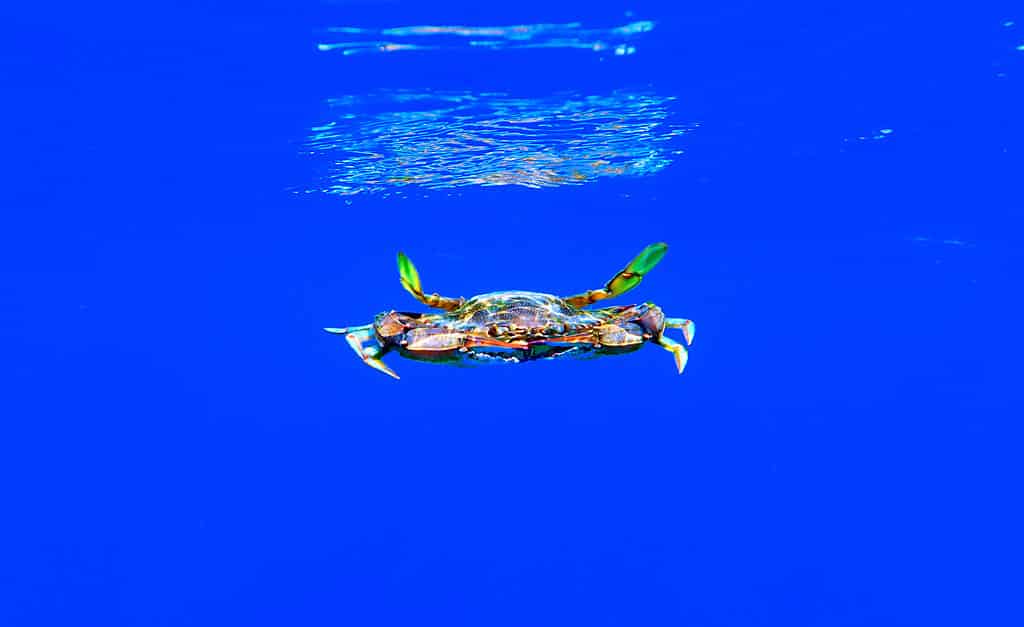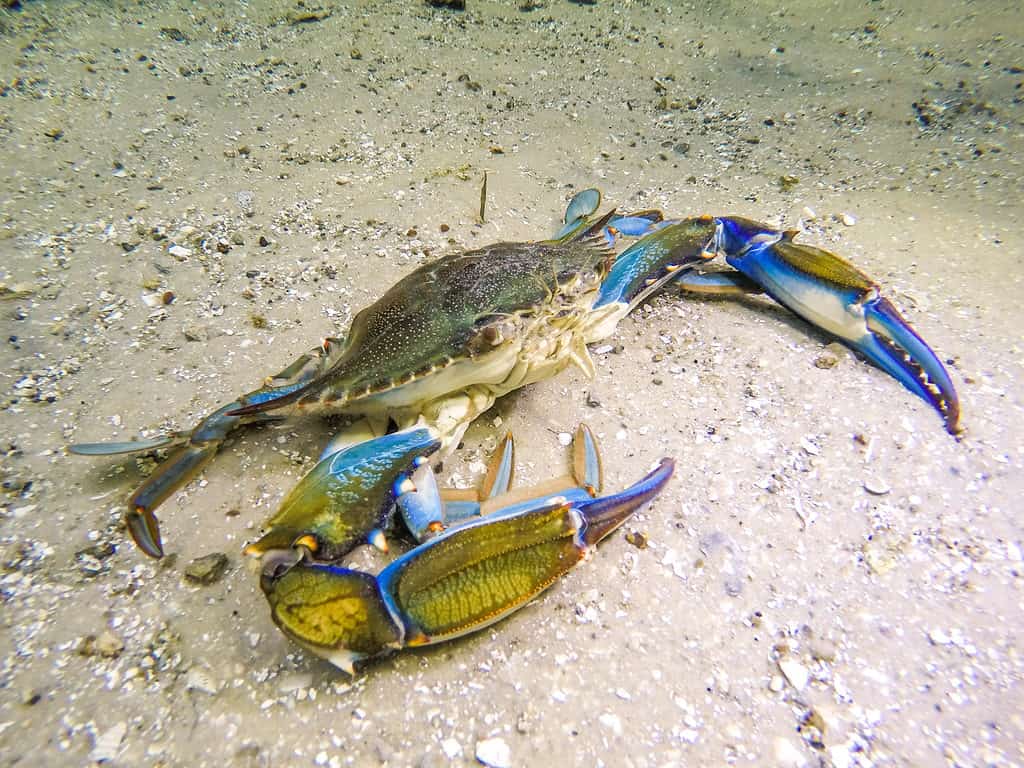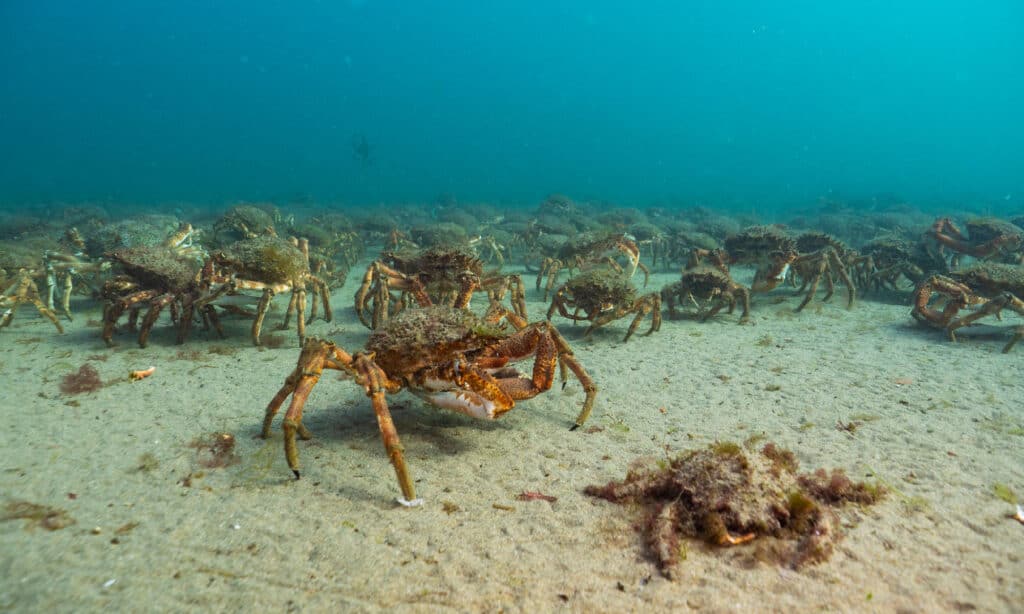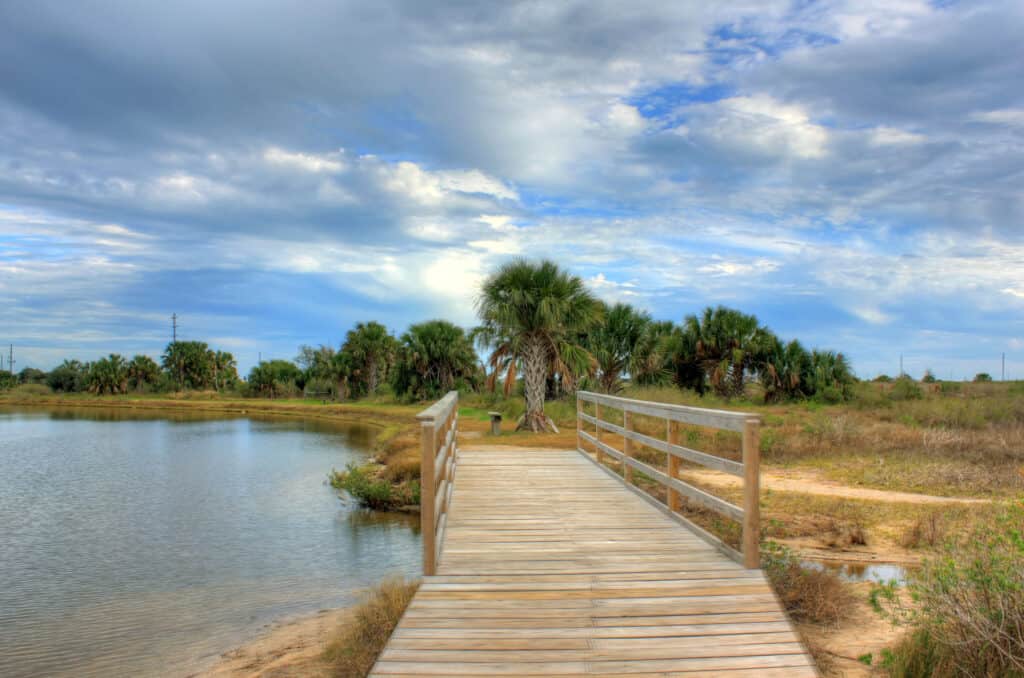
Using a net to bring in a blue crab in Texas is legal.
©Lena605/Shutterstock.com
Crabbing in Texas is one of the favorite pastimes of residents who live near the coast. Blue and stone crabs are found in the waters of the Gulf of Mexico. Anyone can crab. It does not cost much, and you do not need specialized equipment or experience. All you have to have is a piece of string, a piece of chicken, a dip net, a little patience, and a Texas fishing license.
There are few rules and regulations governing this type of fishing in the Lone Star State. All of the details and facts you need to know to have a great crabbing experience are included in the information on this page.
Season Dates

There is no crab season in Texas, where blue crabs are plentiful.
©Irina Kozorog/Shutterstock.com
Crabbing in Texas is a year-round event. There is no specified season. During the week of February 16 – 25, no crabbing is permitted in the coastal waters. All crab traps and nets must be removed from the water. If you discover a crab trap or net in the water this week, you can remove and claim it.
There is no official crab season, but you will catch more crabs during the summer and fall of the year. In the summer and fall, the blue crabs are larger and present in greater numbers. If there has been a lot of rainfall in the days just before you go crabbing, you will not catch as many crabs because the amount of freshwater will drive the crabs farther into the Gulf, where the salt content is higher.
Texas Crab Fishing License

Crabs are seen floating in the water; if you are quick, you can catch them using a net.
©Vojce/Shutterstock.com
Anyone 17 or older must possess a Texas fishing license to catch crab legally. A saltwater stamp is required. There are several combinations of licenses and stamps to choose from. The cost of the licenses depends on whether you are a resident, your age, and the license type. Seniors 65 and older pay less for their licenses.
Licenses expire at the end of August, except for the year-to-date versions. The year-to-date license provides more fishing opportunities for the license holder. When fishing in Texas, ensure you carry your license and a valid form of identification that shows your picture, like a driver’s license or state identification card.
If you have a commercial fishing license, you can legally use it when you are catching personal use crabs. The crabs you catch can’t be sold or traded, and you must follow all regulations for sportsfishermen who are not commercially licensed.
Resident Fishing License Cost
| License | Cost |
| One-day license all water fishing license | $11 |
| Resident Freshwater license | $30 |
| Senior (65 and older) Freshwater License | $12 |
| Resident hunting and fishing super combo license | $68 |
| Senior hunting and fishing super combo license | $32 |
| Resident hunting and freshwater license | $50 |
| Senior hunting and freshwater license | $16 |
| Resident hunting and saltwater license | $55 |
| Senior hunting and salwater license | $21 |
| Resident hunting and all water permit | $60 |
| Senior hunting and all water permit | $26 |
| Special resident license for the blind | $7 |
If you are crabbing, even if you are crabbing in a bayou that is not fresh and saltwater, you must have a saltwater fishing stamp.
Resident License Exceptions
There are some exceptions to the licensing rules that apply to residents.
- Anyone who is less than 17 years of age
- Any person who was born before January 1, 1931.
- A person with an intellectual disability. (This person must be accompanied by a licensed individual. A note from a licensed medical professional stating that the individual has an intellectual disability will be required.)
Non-Resident License Cost
Non-residents have several options on the type of license they purchase.
| License Type | Cost |
| One-day all water fishing license | $16 |
| Non resident freshwater fishing license | $58 |
Exceptions for Non-Residents
- Anyone under the age of 17
- Oklahoma residents over 65 with a valid Oklahoma fishing license.
- Louisiana residents over 65 who have a valid Louisiana fishing license.
Bag Limits for Crabs

There is no bag limit for blue crabs in Texas.
©Jen Helton/Shutterstock.com
Texas does not have a bag limit for blue crabs. However, they have a size limit for both blue and stone crabs.
- Blue crabs must measure five” across the widest portion of their body
- You may keep the largest claw from the stone crab as long as the claw measures 2 1/2. Stone crabs are caught and released.
- Egg-bearing crabs. (These are female crabs that have not laid their eggs. Their apron will feel soft or spongy, indicating a mass of eggs beneath it.
- It is illegal to keep a female crab that is missing their abdominal apron.
When crabbing in Texas it is legal to keep crabs under five inches for bait use. The number of less than five-inch crabs you have must be no more than 5% of your entire catch. You also must have the smaller bait crabs in a separate cooler or holding container.
Identifying Crab Genders
You have to be able to identify the gender of the crab you have caught. The male crab has a narrow apron in the abdomen, and the female has an apron covering most of her underside. It is very easy to distinguish males from females.
Learning to distinguish the male from the female crabs will help the population remain high. The spawning season for the blue crab runs from December until October. The height of the spawning season occurs during the spring and summer months.
Approved Equipment for Crabbing in Texas

Catching crabs in Texas requires getting your bait to the sandy bottom.
©iStock.com/Jake Davies
Besides having a Texas fishing license, anyone crabbing in Texas waters must use the approved fishing gear. You can use your bare hands to catch these crustaceans, but you must quickly do that.
- Crab lines (no more than 6 for each individual with a Texas fishing license)
- Fishing rod with reel.
- Crab trap
- Net, including hand-held and operated dip nets and seines.
- Folding panel trap that does not exceed 16 square feet.
- Sand pump designed to capture ghost shrimp. Must be hand-held and hand-operated.
- Umbrella net made of non-metallic mesh.
Crab Trap Regulations

Crab traps not secured to a pier or dock must be 100′ apart.
©WoodysPhotos/Shutterstock.com
There are guidelines concerning crab traps.
- In public, freshwater crab traps are illegal.
- Crab traps must be 100′ apart unless tied to a pier.
- A fisherman can place no more than three traps in the San Bernardo River.
- Crab traps are limited to three per angler west of Highway 146.
Where To Catch Crabs In Texas

Crabbing is done in salty waters near the coast, including bayous.
©Yinan Chen, Public Domain, via Wikimedia Commons – License
Crabbing success requires fishing in the right spot at the right time. Many people say dawn and dusk are the optimum times for catching crabs, but in the Lone Star State,, at dawn and dusk,, the mosquitos near the coast are vicious.
Marshes, bayous, and straight into the Gulf are all places to find crabs. You will find them in estuaries and the brackish bay waters. When the tide comes in or goes out, the crabs will bite better. You will find the crabbing excellent after a hurricane or tropical storm.
Most people crab using raw chicken pieces as bait. Crabs also eat fish and some anglers throw cast nets to catch mullet and shad which they use in their crab traps. Chicken is the best bait if you are fishing with a string or hand-held line.
The photo featured at the top of this post is © Jen Helton/Shutterstock.com
Thank you for reading! Have some feedback for us? Contact the AZ Animals editorial team.






